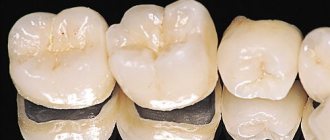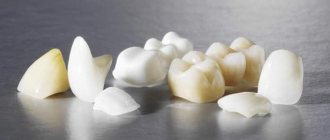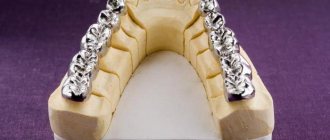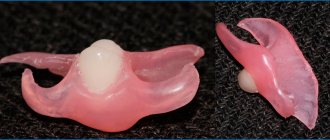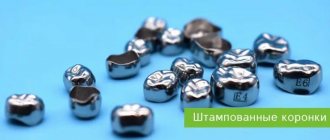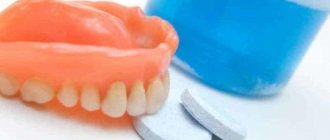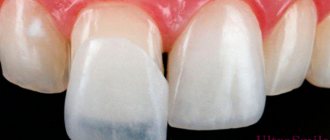When we are seriously faced with the issue of restoring missing teeth, we have to solve several issues at once:
- choice of prosthetic technique;
- selection of material for the prosthesis.
The range of materials for dental prosthetics is now wide, which is better? Metal, plastic or ceramics, or maybe a combination of them? In this article we will try to highlight all the features of metal-ceramic prostheses, as well as the pros and cons of the increasingly popular prostheses made of metal-free ceramics.
What is cermet?
When we say “metal-ceramics,” we most often mean crowns and bridges on a metal frame coated with ceramic. Otherwise, it is an orthopedic base made of metal, repeating the shape of a tooth ground for a crown, which is covered on top with a layer of thin ceramics. Ceramic metal is less likely than other materials to cause allergies. Metal-ceramics are used mainly for dental prosthetics in the chewing region, where preference is given not so much to aesthetic qualities as to reliability and functionality.
Prosthetics with metal-ceramics.
As already noted, metal-ceramics have found their application more in the prosthetics of chewing teeth, where the main thing is strength, not appearance. However, this does not mean that metal ceramics are completely devoid of aesthetics, not at all. The widest range of ceramic coatings allows metal-ceramic crowns to perfectly imitate the shade and structure of natural tooth tissue.
The problem may arise when prosthetics are placed on the front teeth. It is as follows: a dark metal frame can show through a layer of ceramics, that is, the metal simply shines through the translucent coating. Therefore, when replacing anterior teeth, it is most often recommended to use metal-free ceramics or ceramics based on zirconium (zirconium dioxide) - this is, in fact, the same metal ceramics, but the frame material is white metal - zirconium, by the way, is absolutely biocompatible with the human body .
Metal-plastic
Like metal-ceramics, metal-plastic prostheses consist of a metal frame and coating. The only difference is in the material from which the top layer is made. For this purpose, high-strength dental plastic is used, which is characterized by non-toxicity, a strong connection with the metal, and the ability to well imitate the surface of the tooth.
Plastic crowns
Such prostheses are installed in the following situations:
- as temporary structures designed to replace missing teeth while metal-ceramic dentures are being manufactured;
- as an external coating for implants with a metal base;
- when combining several types of prosthetics to restore the dentition;
- for prosthetics of individual front or chewing teeth.
Metal-plastic cast crowns
Metal-ceramic prostheses.
What is a metal-ceramic prosthesis upon closer examination? First of all, it is a metal frame covered with a layer of hypoallergenic ceramics. If we compare modern metal-ceramic prostheses with their predecessors made of various composites, we will see the undoubted advantages of metal-ceramics:
- firstly, metal-ceramics reproduces the color and texture of natural tooth tissues quite well;
- secondly, it does not fade, does not absorb dyes and, therefore, does not change color over time;
- thirdly, dental ceramics used in dentures are hypoallergenic and do not cause rejection, except in rare cases;
- and finally, cermets are very durable.
If we are talking about removable dentures made of metal ceramics, then we are talking about a clasp denture. “Bugel” (clasp) means “arc”, and the prosthesis itself is precisely a metal arch with metal-ceramic crowns attached to it. Removable metal-ceramic structures are used when there are contraindications to installing a permanent metal-ceramic prosthesis.
Advantages and disadvantages of metal ceramics.
Patients who decide to have metal-ceramic prosthetics often ask themselves and their doctor the question: can metal-ceramics cause harm?
If the prosthesis is made by professionals from high-quality certified materials in a laboratory in compliance with relevant standards, then the danger of such prosthetics is minimal and practically eliminated. The materials that are used in the manufacture of metal-ceramic crowns are themselves non-toxic, but, nevertheless, they can behave differently in the oral cavity. For example, nickel in frames made of chromium-nickel alloys can cause an allergic reaction. And structures made from base metals can oxidize over time due to a reaction with saliva.
In general terms, the advantages of metal-ceramic prostheses include their durability and strength, while the disadvantages are the need for deeper treatment of the tissues of a living tooth, as well as exposure of the frame when the gums recede and the metal base is visible through the ceramic (the exception is zirconium crowns).
Strength:
Today, metal-ceramic structures are installed mainly on teeth exposed to significant chewing load, although until quite recently they were used everywhere. Metal-free ceramic crowns, on the contrary, did not enjoy increased popularity due to the fragility of their design, and therefore were mainly used to restore front teeth.
But with the advent of zirconium dioxide frames in dentistry, the situation has changed dramatically. An increasing number of both dentists and patients are inclined to use these new materials for prosthetics of both chewing and frontal teeth.
The ultra-strength of cermets also has a downside. Damage occurs to the teeth in contact with the metal-ceramic prosthesis, which can lead to their premature and excessive wear. Whereas the hardness coefficient of ceramic prostheses based on zirconium dioxide is very close to the hardness coefficient of real teeth, therefore, when in contact with a prosthesis made of metal-free ceramics, the opposing teeth are not injured from the impact load.
Allergy:
Allergies in the design of a metal-ceramic prosthesis are caused not by ceramics, which are hypoallergenic, but by the metals used in the frame. Symptoms of an allergy to metal ceramics may include:
- burning sensation in the gums or tongue;
- metallic taste in the mouth;
- swelling and swelling at the site of contact with the crown.
If you experience any of these phenomena after installing a metal-ceramic crown, contact your dentist immediately. If you are allergic to metal-ceramics, there is a way out - this is replacing the metal-ceramic crown with an all-ceramic metal-free orthopedic structure.
Color:
Dental ceramics allow you to choose any color that perfectly matches the natural color of the patient’s teeth. The shade is carefully selected by the dental technician using a special Vita scale.
A metal-ceramic crown will not change color over time and will not fade because it does not absorb pigment at all, unlike composite materials from which fillings are made. For all the above reasons, metal ceramics do not require special bleaching.
Durability:
The main misconception of happy owners of metal-ceramic prostheses is ignoring the service life of such a structure. All patients are confident that it is enough to install a metal-ceramic crown once and for all, and it will serve for the rest of their lives. Let us immediately refute this false statement; it is not true! No matter how regrettable it may be, the service life of any metal-ceramic prosthesis is limited on average from 5 to 12 years.
The key to the longevity of the prosthesis is its high-quality production using individually and precisely made casts, as well as the patient’s compliance with all recommendations for its care when wearing it.
Dental clinics provide a guarantee for metal-ceramics for a period of one to three years, taking into account the frame material and the clinic’s policy. According to the warranty terms, the crown must maintain its integrity and not be subject to destruction under mechanical influence for a certain period specified in the warranty. The crown may last the stated time, however, remember that the most “popular” reason for the crown to fall out is not its damage, but secondary caries that has developed under the crown. To avoid this situation, do not neglect regular preventive examinations and do not delay replacing worn-out orthopedic structures with new ones.
Ceramic metal, like any other material, has a service life, after which the product made from it wears out and becomes unusable, as it cannot fully perform its functions. Ignoring the service life of metal-ceramic dentures can lead to tooth loss!
What to give preference to?
Depending on the goals of prosthetics and the financial capabilities of the patient, dentists can install dentures made using various technologies and using a wide variety of materials. The most reliable, durable and aesthetic prostheses require the use of expensive materials for their creation. Another factor influencing the choice of material is the location of the tooth that needs restoration.
Making the right choice
The plastic used in dentistry is of high quality, perfectly recreates the structure of tooth enamel and the shade of living teeth, and is hypoallergenic. However, in a number of characteristics this material is much inferior to metal ceramics. Therefore, when choosing between these two materials for dental prosthetics, it is recommended to give preference to metal-ceramics.
Metal-plastic prostheses are less reliable. They are unable to imitate the surface of natural teeth as well as metal-ceramics. Metal-plastic prostheses are used primarily as a temporary measure for the period while the process of manufacturing metal-ceramic structures is underway or if time is needed for the patient’s body to get used to the implant. Installing metal-plastic crowns for a long time is not justified also for the reason that plastic deteriorates much faster than metal.
3 best options for removable dentures for complete absence of teeth
| Photo | Name | Description |
| Acrylic prosthesis | The material is affordable, but due to its hardness it is the most difficult to get used to. Such prostheses are not recommended for people with traumatic work. In addition, acrylic can cause allergic reactions | |
| Nylon prosthesis | Nylon, on the other hand, is hypoallergenic and soft. It's easier to get used to. In terms of aesthetic qualities, nylon is many times superior to acrylic: such a prosthesis cannot be visually distinguished from natural tissues | |
| Acri-free prosthesis | Constructions made from acry-free material are even thinner and lighter. They are somewhat stiffer than nylon ones, but unlike the latter they can be adjusted in case of damage. But their cost is slightly higher |
Metal ceramics VS Ceramics.
If you have indications for prosthetics with a “bridge” or crowns, it is logical that you will begin to ask the question “What is better to install: metal-ceramics or ceramics?”
So, how are they different? Metal-based ceramics and metal-free ceramics will differ in their aesthetic properties, functionality and, of course, price. Of course, a metal-ceramic prosthesis is durable, incomparable to the strength of an all-ceramic one, but it is not always appropriate for prosthetics in the smile area. In this regard, if we are talking about the restoration of the frontal dentition, then in all respects prostheses made of metal-free ceramics win. Therefore, metal-free crowns for the front teeth certainly have superior aesthetic properties.
However, prices for all-ceramic dentures are higher. Therefore, if you want to restore teeth in the chewing section, affordable metal-ceramics will be very acceptable there - it has the necessary strength, and aesthetic defects are unlikely to be visible in the lateral sections.
Plastic as an option for prosthetics
It is most often used for the anterior teeth and also for the upper premolars . Recently, very often plastic crowns are used as temporary ones. This is a mandatory stage for proper prosthetics, at which another component can subsequently be installed.
But some patients opt for the plastic option because they are satisfied with the appearance and cost of the finished structure. This option has some deviations due to the fact that it is not suitable for many people. Plastic cannot be installed for those citizens who have periodontal diseases. Over time, the plastic will simply begin to absorb plaque . If you choose the right color, you can see clear advantages over other options.
In addition, for a low cost, you will carry out all the procedures immediately. But we should talk about the disadvantages. The crown manufacturing technology will involve extensive processing of hard tissue. The walls must be much thicker than metal so that the crown structure does not fall apart after a few months.
Metal ceramics VS Metal.
All-metal crowns compare favorably with metal-ceramics in price and are not inferior in structural strength. But there are a few “buts”:
- metal can imitate a natural tooth only in terms of anatomical shape (the “iron teeth” effect);
- metal teeth destroy the teeth they come into contact with, increasing their
Metal ceramics VS Zirconium dioxide.
frame of metal-ceramic crowns
crown frame based on zirconium dioxide
We have already explained the differences between metal ceramics and ceramics based on zirconium dioxide. In principle, zirconium is the same metal, which is favorably distinguished by its aesthetic properties (white color) and absolute biocompatibility, but is less favorably distinguished by its price. When choosing a material for dental prosthetics in the smile area, it would be logical to give preference to crowns on a zirconium frame. When restoring chewing teeth, it will be cheaper to install metal ceramics. If the patient has metal intolerance, the solution would be to install a prosthesis on a zirconium frame.
Pros and cons of metal-plastic
The main advantages of metal-plastic prostheses:
- Removable dentures - a detailed overview of the types, which are the best and how to properly care for them
- fast production times;
- ease of repair if necessary;
- relatively non-traumatic installation;
- affordable price.
Advantages of metal-plastic dentures
The disadvantages include:
- short service life (maximum 3 years);
- fragility, which leads to chipping and deformation;
- the porous composition of the material promotes staining under the influence of food dyes, which worsens the appearance of teeth;
- poor fit, resulting in bad odor due to food particles getting stuck under the denture.
Metal-plastic crowns for teeth
How to install metal ceramics?
Installation of metal ceramics occurs in several stages. First, the patient needs to undergo a general examination, diagnostics and dental treatment, if necessary.
After this, the teeth are prepared for a crown: the enamel is ground down, the nerve is removed (if the condition of the supporting teeth is good, the doctor can leave them alive).
Impressions are taken from the ground teeth, from which individual orthopedic structures are made in the laboratory. Thus, the production and installation of metal-ceramic prostheses takes on average about two weeks.
Keep in mind that grinding for an all-ceramic crown is more gentle, this is due to the thickness of the crown itself (a ceramic crown is thinner). Usually the tooth is not ground down completely; a ledge is formed at the border with the gum, which does not allow the metal frame to come into contact with the gum and, thus, reduces the risks of developing allergies, tissue irritation, bleeding gums and swelling.
How to properly care for metal-ceramic dentures?
There is nothing supernatural in caring for metal-ceramic structures. It is necessary to brush your teeth morning and evening. No special brushes or cleaning equipment are required. A regular toothbrush will work fine. The main thing is not how to clean it, but how! Pay attention to the movements when cleaning: they should be sweeping, that is, directed from the gums to the edge. If, however, we talk about any specific devices recommended for cleaning metal-ceramic dentures, use dental floss and an irrigator.
If you have the feeling that a tooth or teeth under metal-ceramics hurt or ache, consult a doctor immediately, as pain may be a symptom of secondary caries that has developed under the crown.
In some cases, restoration of a metal-ceramic orthopedic structure may be required. For example, if metal ceramics break off right in the mouth. If the metal frame is not exposed, then most likely the chip is minor and can be restored using composite materials in the oral cavity. Unfortunately, if the frame of the prosthesis is exposed, then reconstruction is impossible. Most likely, you will need to remove the damaged metal-ceramic prosthesis and install a new one in its place. Remember about the service life of metal-ceramics; replacing them in a timely manner will help avoid problems and save the tooth.
Comparison and distinctive features
If we talk about the differences between these two methods, it should be noted:
- Price . Plastic crowns are one of the cheapest options that anyone can afford. But if we talk about the competitor, then this is an elite method of dental restoration that will delight you for a long time without changing the original appearance.
- Durability . Metal-ceramics are installed for many years, because the strength here is at the highest level. If we talk about plastic, then after a short period of time you may experience cracks and chips.
- Effect on teeth . Metal ceramics will never remove plaque from teeth and change their appearance. If we talk about plastic, it can change its shade under the influence of your bone tissue.
- Plastic crowns are made much faster and are installed at the same pace. If we talk about metal ceramics, then this is a different material. The specialist takes a more responsible approach to the manufacture, as well as further prosthetics.
